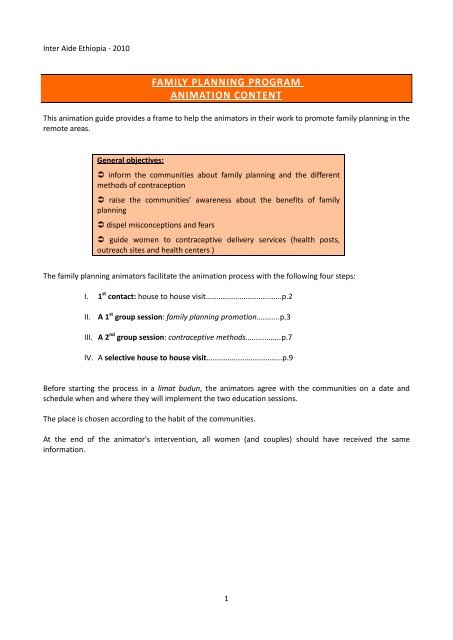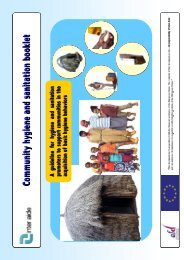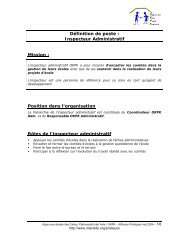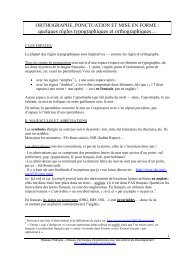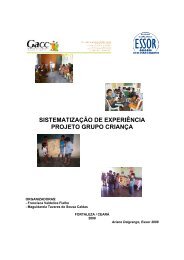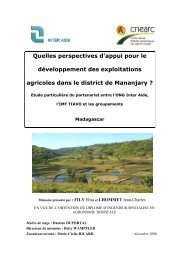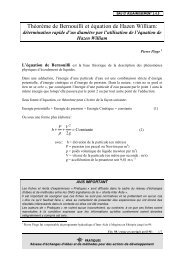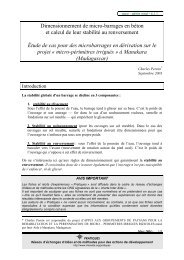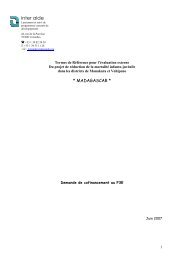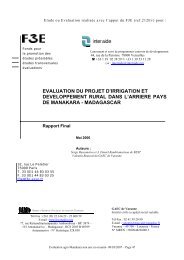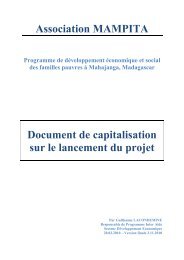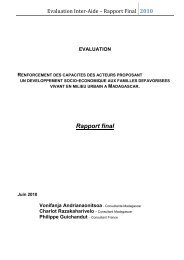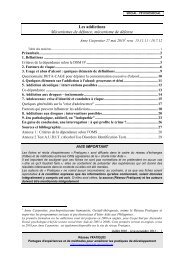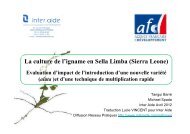FAMILY PLANNING PROGRAM ANIMATION CONTENT - Inter Aide
FAMILY PLANNING PROGRAM ANIMATION CONTENT - Inter Aide
FAMILY PLANNING PROGRAM ANIMATION CONTENT - Inter Aide
Create successful ePaper yourself
Turn your PDF publications into a flip-book with our unique Google optimized e-Paper software.
<strong>Inter</strong> <strong>Aide</strong> Ethiopia - 2010<br />
<strong>FAMILY</strong> <strong>PLANNING</strong> <strong>PROGRAM</strong><br />
<strong>ANIMATION</strong> <strong>CONTENT</strong><br />
This animation guide provides a frame to help the animators in their work to promote family planning in the<br />
remote areas.<br />
General objectives:<br />
� inform the communities about family planning and the different<br />
methods of contraception<br />
� raise the communities’ awareness about the benefits of family<br />
planning<br />
� dispel misconceptions and fears<br />
� guide women to contraceptive delivery services (health posts,<br />
outreach sites and health centers )<br />
The family planning animators facilitate the animation process with the following four steps:<br />
I. 1 st contact: house to house visit....................................p.2<br />
II. A 1 st group session: family planning promotion...........p.3<br />
III. A 2 nd group session: contraceptive methods.................p.7<br />
IV. A selective house to house visit....................................p.9<br />
Before starting the process in a limat budun, the animators agree with the communities on a date and<br />
schedule when and where they will implement the two education sessions.<br />
The place is chosen according to the habit of the communities.<br />
At the end of the animator's intervention, all women (and couples) should have received the same<br />
information.<br />
1
STEPT 1: 1 st contact (house to house)<br />
Recommended duration per household: 15 minutes<br />
Objectives:<br />
� to introduce yourself and the project<br />
� to invite the family to the following education sessions<br />
� to give to the family the desire to participate in the sessions<br />
a. Present <strong>Inter</strong> <strong>Aide</strong> programs and the animator’s mission.<br />
b. Give a brief description of the family planning:<br />
Family planning is a method which allows you to plan when you want to have children and how many<br />
you want to have.<br />
c. Explain the purpose of the two education sessions you will facilitate, with the precise location and dates.<br />
5 main situations can be encountered<br />
���� the woman is user, already under contraceptive: invite her to share her experience in the group<br />
session.<br />
���� the woman is not user and don't know what family planning is: explain her briefly and invite her to<br />
come to learn about Family planning.<br />
���� the woman refuses to discuss about family planning, try to make her confident and to know the<br />
reason of refusal. If she refuses to come in the group session, you can propose to visit her in the<br />
selective house to house visit (4 th stage).<br />
���� the woman is a former user: she stopped using contraceptive because she has some fears of sideeffects:<br />
tell her to come in the group session in order to get more information about side effects or<br />
beliefs.<br />
���� the house is empty: you should remember this house and come back, all the household have to be<br />
visited.<br />
As much as possible, discuss also with the husbands and invite them for the first educational session.<br />
Cross check each house you visit putting a mark on the door.<br />
� Do not forget:<br />
• a precise date and place for the sessions<br />
• give a particular attention to the young women ( 16 - 25 years old )<br />
2
STEP 2: First group session about Family Planning<br />
Recommended duration: 1h30<br />
Recommended target group: 10 - 20 persons<br />
Objectives:<br />
� to know what is family planning<br />
� to understand the advantages of family planning<br />
� to get out false beliefs about family planning<br />
a. First story<br />
Recommended duration: 30 minutes<br />
To open the discussion and ask the knowledge and beliefs of the group, the animator can use this story and<br />
show the pictures:<br />
“ A father and his son were planting corn. The son asked his father why the corn wasn't planted closer<br />
together in order to obtain more per hectare. The father explained that if there is space between the plants,<br />
they grow stronger and healthier and produce more grain. Can you see the relationship between little corn<br />
plants and children?”<br />
TOO CROWDED<br />
3<br />
WELL SPACED<br />
They do not grow well. They grow healthy and strong.
. Second story:<br />
Recommended duration: 30 minutes<br />
Almaz and Abebe is a young married couple. They are farmers and have already one child.<br />
Discussion between the husband and wife<br />
Almaz and Abebe discussion<br />
One day Almaz asked her husband if he knew<br />
what family planning is.<br />
She knew some women who were using this to<br />
have a gap between the children.<br />
Abebe answered that he didn't know about<br />
family planning but it was better to let God<br />
choose when they will have children or not.<br />
Almaz said that even in the church, they were told that it was good to use this modern method. They said<br />
that it is good for mother and child health and for the economic situation of the family and the<br />
communities. Abebe did not totally agree with this but accepted to go with her to the health post to get<br />
more information.<br />
In the Health Post<br />
Almaz and Abebe with the Health Extension Worker (HEW)<br />
money to buy this food.<br />
Abebe and Almaz went to the health post and meet Emabet, the<br />
HEW. Abebe asked the HEW, “my wife told me about this child<br />
spacing method but what is the real benefits of this?<br />
Emabet said that these methods allow to choose when you want<br />
to have a child. It is better for the mother health to have some<br />
space between pregnancies. It also gives her more time to take<br />
care of the children and to do other things.<br />
Abebe asked “but if she starts to take this method, can she be<br />
pregnant afterwards?"<br />
Emabet answered that the contraceptives do not make women<br />
sterile. When the woman stops, she can become pregnant again<br />
as before.<br />
Almaz heard that when the women take the contraceptives, they<br />
need to eat special food and she is afraid because they don't have<br />
Emabet told her that she can eat normal food; there is no need to change the food habit. Then, she<br />
explains them the different contraceptive methods.<br />
4
A planned family<br />
Almaz and Abebe family<br />
Almaz and Abebe have decided to plan their family.<br />
After this discussion, Abebe and Almaz became confident<br />
with family planning.<br />
Almaz choose the method she preferred. And they decided<br />
to have four children with four years space between each.<br />
The older ones go to school, help their parents in the farm<br />
and take care of the younger ones.<br />
Almaz is in good health, she started to study again and<br />
became a Health Extension Worker.<br />
c. Key points to remember<br />
10 minutes<br />
Contraception does not make the women sterile<br />
This woman took a contraceptive between two pregnancies.<br />
5
Churches are in favor for family planning<br />
Women under contraceptive do not need special food<br />
Contraceptive is free<br />
d. Discussion about group's understanding and conclusion<br />
20 minutes<br />
6
STEP 3: Second group session about "Contraceptive methods"<br />
Recommended duration: 1h30<br />
Recommended target group: 10 - 20 women.<br />
Objectives:<br />
� to know the different methods of contraceptives, how it works, advantages and<br />
disadvantages<br />
� to take out the fears of side effects<br />
� to guide the women who want to the nearest contraceptive services<br />
The animator will describe the four main contraceptive methods accessible in the health posts. Natural<br />
methods exist but are not totally reliable. This session only focuses on the modern methods.<br />
Depo provera: injection every three months<br />
How it works: it stops ‘eggs’ (ovum) from being released from the<br />
ovaries<br />
Advantages: it is a reliable method; it is very easy to use.<br />
Disadvantage: the woman has to remember to get a new injection<br />
every 3 months. It takes a few months to become fertile once you stop<br />
the injection. It can cause irregular periods and sometimes stop it,<br />
particularly in the first months.<br />
Pills: “medicine” to take every day<br />
How it works: prevent the maturation of the egg so that the<br />
fertilization cannot occur.<br />
Advantages: prevents anemia because it reduces menstrual flow, it is a<br />
very reliable method and is easy to use. It also reduces menstrual pain<br />
Disadvantages: a pill must be taken everyday and can easily be<br />
forgotten. If a woman forgets to take a pill, she must use another<br />
contraceptive method for the rest of her cycle to prevent pregnancy.<br />
7
Condoms: masculine preservative<br />
How it works: prevent contact of semen and vagina.<br />
Advantages: condoms can be bought in many places, can be used by<br />
everybody, very reliable when used correctly. It’s the only contraceptive<br />
method that prevents against AIDS/STIs<br />
Disadvantages: Condoms can only be used once; it can burst if not used<br />
correctly, it can lower sexual satisfaction.<br />
The condoms are accessible in the Health Posts and Health Centers<br />
freely. The Health Extension Workers can show how to use it.<br />
Implant (if available): little stick inserted in the arm,<br />
How it works: it stops the eggs and the efficiency of sperm (male<br />
liquid).<br />
Advantages: very easy to use, no risk to forget, efficient during 3 or<br />
5 years, weight gain can occur.<br />
Disadvantages: irregular periods or prolonged bleeding (at the<br />
beginning), headaches, acne. Implant can be inserted at the health<br />
post but it has to be removed at the Health Center.<br />
At the end of this session, inform the group when and where they can find the contraceptives. Encourage<br />
them to ask the Health Extension Worker for more information. The women body reacts differently to the<br />
different methods: some may have side effects while others don’t. If the side-effects are not tolerated, they<br />
should ask the Health extension to change the method.<br />
Take a discussion time with the group.<br />
� Do not forget<br />
• Contraception is not dangerous for the health.<br />
• Side-effects are not a reason to stop family planning: method can be changed.<br />
• Contraception is free and accessible in the Health Posts, Health Centers, and in<br />
outreach sites.<br />
8
This fourth step is dedicated to:<br />
STEP 4: Specific family support<br />
- Women who have shown difficulties to understand the key messages<br />
During the session some women may show difficulties in understanding the messages, or may have been<br />
uncomfortable with the subject. An individual contact with these women can make them more confident<br />
and help them dispel misunderstanding.<br />
- Women who did not attend the group sessions: with a priority for younger women<br />
If you identified women who didn't come to the session, try to meet them in their house and to have a<br />
discussion with them about Family Planning, to get their point of view and give them the main information.<br />
- Young married women (as they constitute our main target group)<br />
The young married women, as they don't have already lot of children, are the target group which<br />
can really benefit from family planning and starting contraceptives.<br />
- Young unmarried women<br />
Women who are not married may also have sexual activities, even if it is not socially accepted, the<br />
animator can't ignore it. This activity is hidden and the taking of contraceptive also. It is difficult for these<br />
women to take contraceptive in the outreach sites or in the health posts where they are well known. In this<br />
case, you can advice them to go in the health center, which is more anonymous, and choose a contraceptive<br />
that is adapted to their situation such as condoms to prevent the transmission of HIV/AIDS and sexual<br />
diseases.<br />
9<br />
<strong>Inter</strong> <strong>Aide</strong> Ethiopia - 2010


